Hydrological mass-balance output
Contents
Hydrological mass-balance output#
New in version 1.5!
In two recent PRs (GH1224, GH1232 and GH1242), we have added a new task in OGGM, run_with_hydro, which adds mass-balance and runoff diagnostics to the OGGM output files.
This task is still experimental - it is tested for consistency and mass-conservation and we trust its output, but its API and functionalites might change in the future (in particular to make it faster and to add more functionality, as explained below).
import matplotlib.pyplot as plt
import xarray as xr
import numpy as np
import pandas as pd
import seaborn as sns
# Make pretty plots
sns.set_style('ticks')
sns.set_context('notebook')
from oggm import cfg, utils, workflow, tasks, graphics
cfg.initialize(logging_level='WARNING')
cfg.PATHS['working_dir'] = utils.gettempdir(dirname='OGGMHydro')
cfg.PARAMS['store_model_geometry'] = True # Hydro outputs needs the full model geometry
2023-03-07 12:27:28: oggm.cfg: Reading default parameters from the OGGM `params.cfg` configuration file.
2023-03-07 12:27:28: oggm.cfg: Multiprocessing switched OFF according to the parameter file.
2023-03-07 12:27:28: oggm.cfg: Multiprocessing: using all available processors (N=2)
2023-03-07 12:27:28: oggm.cfg: PARAMS['store_model_geometry'] changed from `False` to `True`.
Define the glacier we will play with#
For this notebook we use the Hintereisferner, Austria. Some other possibilities to play with:
Shallap Glacier: RGI60-16.02207
Artesonraju: RGI60-16.02444 (reference glacier)
Hintereisferner: RGI60-11.00897 (reference glacier)
And virtually any glacier you can find the RGI Id from, e.g. in the GLIMS viewer.
# Hintereisferner
rgi_id = 'RGI60-11.00897'
Preparing the glacier data#
This can take up to a few minutes on the first call because of the download of the required data:
# We pick the elevation-bands glaciers because they run a bit faster
base_url = 'https://cluster.klima.uni-bremen.de/~oggm/gdirs/oggm_v1.4/L3-L5_files/CRU/elev_bands/qc3/pcp2.5/no_match'
gdir = workflow.init_glacier_directories([rgi_id], from_prepro_level=5, prepro_border=80, prepro_base_url=base_url)[0]
2023-03-07 12:27:28: oggm.workflow: init_glacier_directories from prepro level 5 on 1 glaciers.
2023-03-07 12:27:28: oggm.workflow: Execute entity tasks [gdir_from_prepro] on 1 glaciers
“Commitment run”#
This runs a simulation for 100 yrs under a constant climate based on the climate of the last 11 years:
# file identifier where the model output is saved
file_id = '_ct'
tasks.run_with_hydro(gdir, run_task=tasks.run_constant_climate, nyears=100, y0=2014, halfsize=5, store_monthly_hydro=True,
output_filesuffix=file_id);
/usr/local/pyenv/versions/3.10.10/lib/python3.10/site-packages/oggm/utils/_workflow.py:2939: UserWarning: Unpickling a shapely <2.0 geometry object. Please save the pickle again; shapely 2.1 will not have this compatibility.
out = pickle.load(f)
/usr/local/pyenv/versions/3.10.10/lib/python3.10/site-packages/oggm/utils/_workflow.py:2939: UserWarning: Unpickling a shapely <2.0 geometry object. Please save the pickle again; shapely 2.1 will not have this compatibility.
out = pickle.load(f)
Let’s have a look at the output:
with xr.open_dataset(gdir.get_filepath('model_diagnostics', filesuffix=file_id)) as ds:
# The last step of hydrological output is NaN (we can't compute it for this year)
ds = ds.isel(time=slice(0, -1)).load()
There are plenty of new variables in this dataset! We can list them with:
ds
<xarray.Dataset>
Dimensions: (time: 100, month_2d: 12)
Coordinates:
* time (time) float64 0.0 1.0 2.0 ... 97.0 98.0 99.0
hydro_year (time) int64 0 1 2 3 4 5 ... 94 95 96 97 98 99
hydro_month (time) int64 1 1 1 1 1 1 1 1 ... 1 1 1 1 1 1 1
calendar_year (time) int64 -1 0 1 2 3 4 ... 94 95 96 97 98
calendar_month (time) int64 10 10 10 10 10 ... 10 10 10 10 10
* month_2d (month_2d) int64 1 2 3 4 5 6 7 8 9 10 11 12
calendar_month_2d (month_2d) int64 10 11 12 1 2 3 4 5 6 7 8 9
Data variables: (12/21)
volume_m3 (time) float64 6.305e+08 ... 8.315e+07
volume_bsl_m3 (time) float64 0.0 0.0 0.0 0.0 ... 0.0 0.0 0.0
volume_bwl_m3 (time) float64 0.0 0.0 0.0 0.0 ... 0.0 0.0 0.0
area_m2 (time) float64 8.036e+06 ... 2.501e+06
length_m (time) float64 5.6e+03 5.7e+03 ... 1.1e+03
calving_m3 (time) float64 0.0 0.0 0.0 0.0 ... 0.0 0.0 0.0
... ...
liq_prcp_on_glacier (time) float64 1.034e+10 ... 2.419e+09
liq_prcp_on_glacier_monthly (time, month_2d) float64 2.42e+08 ... 2.159...
snowfall_off_glacier (time) float64 0.108 5.96e+07 ... 1.191e+10
snowfall_off_glacier_monthly (time, month_2d) float64 0.002158 ... 2.46e+08
snowfall_on_glacier (time) float64 1.945e+10 ... 6.851e+09
snowfall_on_glacier_monthly (time, month_2d) float64 1.969e+09 ... 4.89...
Attributes:
description: OGGM model output
oggm_version: 1.5.3
calendar: 365-day no leap
creation_date: 2023-03-07 12:27:29
water_level: 0
glen_a: 6.774049426121393e-24
fs: 0
mb_model_class: MultipleFlowlineMassBalance
mb_model_hemisphere: nhAnnual runoff#
The annual variables are stored as usual with the time dimension. For example:
ds.volume_m3.plot();
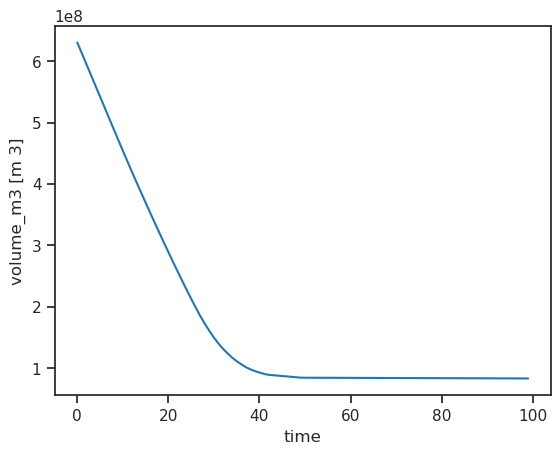
The new hydrological variables are also available. Let’s make a pandas DataFrame of all “1D” (annual) variables:
sel_vars = [v for v in ds.variables if 'month_2d' not in ds[v].dims]
df_annual = ds[sel_vars].to_dataframe()
The hydrological variables are computed on the largest possible area that was covered by glacier ice in the simulation. This is equivalent to the runoff that would be measured at a fixed-gauge station at the glacier terminus. The total annual runoff is:
# Select only the runoff variables and convert them to megatonnes (instead of kg)
runoff_vars = ['melt_off_glacier', 'melt_on_glacier', 'liq_prcp_off_glacier', 'liq_prcp_on_glacier']
df_runoff = df_annual[runoff_vars] * 1e-9
df_runoff.sum(axis=1).plot(); plt.ylabel('Mt');
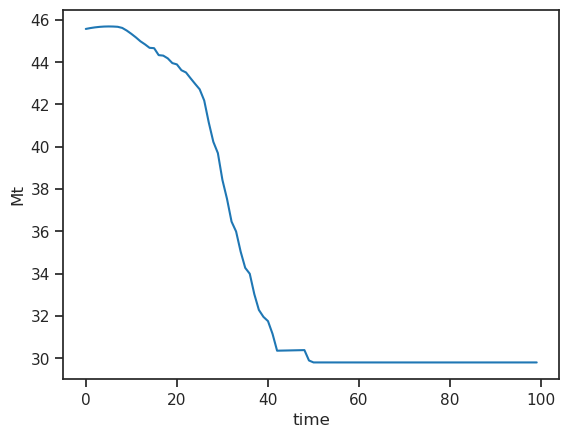
It consists of the following components:
melt off-glacier: snow melt on areas that are now glacier free (i.e. 0 in the year of largest glacier extent, in this example at the start of the simulation)
melt on-glacier: ice + seasonal snow melt on the glacier
liquid precipitaton on- and off-glacier (the latter being zero at the year of largest glacial extent, in this example at start of the simulation)
f, ax = plt.subplots(figsize=(10, 6));
df_runoff.plot.area(ax=ax, color=sns.color_palette("rocket")); plt.xlabel('Years'); plt.ylabel('Runoff (Mt)'); plt.title(rgi_id);
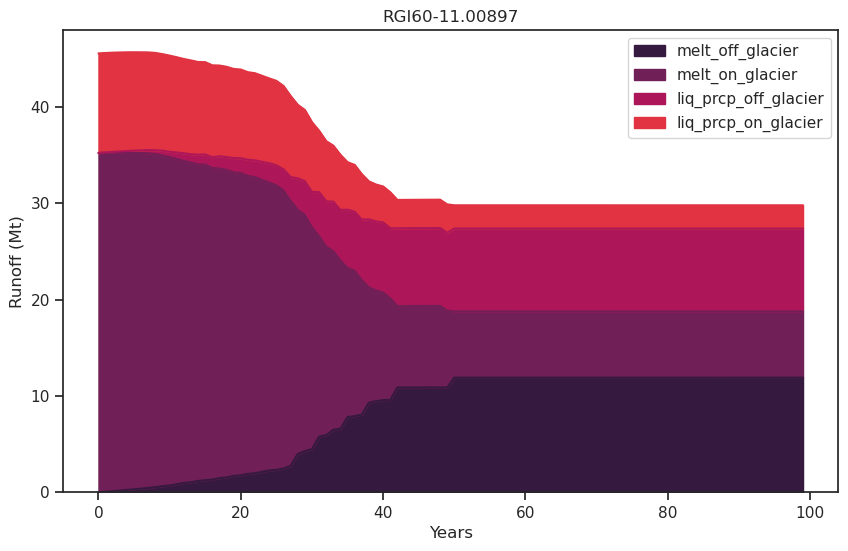
As the glacier retreats, total runoff decreases as a result of the decreasing glacier contribution.
Monthly runoff#
The “2D” variables contain the same data but at monthly resolution, with the dimension (time, month). For example, runoff can be computed the same way:
# Select only the runoff variables and convert them to megatonnes (instead of kg)
monthly_runoff = ds['melt_off_glacier_monthly'] + ds['melt_on_glacier_monthly'] + ds['liq_prcp_off_glacier_monthly'] + ds['liq_prcp_on_glacier_monthly']
monthly_runoff *= 1e-9
monthly_runoff.clip(0).plot(cmap='Blues', cbar_kwargs={'label':'Mt'}); plt.xlabel('Months'); plt.ylabel('Years');
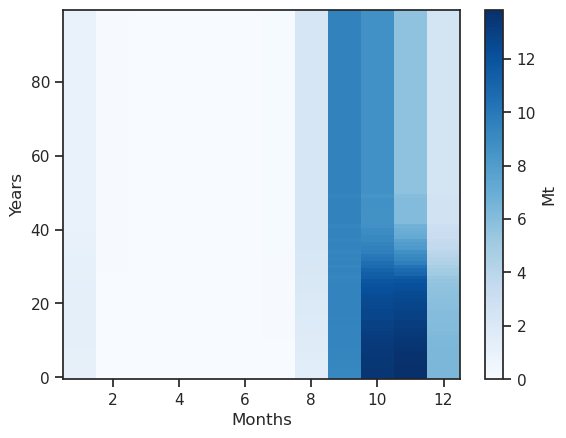
Something is a bit wrong: the coordinates are hydrological months - let’s make this better:
# This should work in both hemispheres maybe?
ds_roll = ds.roll(month_2d=ds['calendar_month_2d'].data[0]-1, roll_coords=True)
ds_roll['month_2d'] = ds_roll['calendar_month_2d']
# Select only the runoff variables and convert them to megatonnes (instead of kg)
monthly_runoff = ds_roll['melt_off_glacier_monthly'] + ds_roll['melt_on_glacier_monthly'] + ds_roll['liq_prcp_off_glacier_monthly'] + ds_roll['liq_prcp_on_glacier_monthly']
monthly_runoff *= 1e-9
monthly_runoff.clip(0).plot(cmap='Blues', cbar_kwargs={'label':'Mt'}); plt.xlabel('Months'); plt.ylabel('Years');
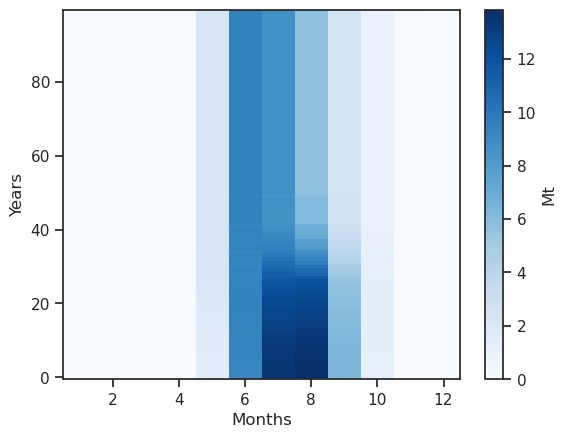
monthly_runoff.sel(month_2d=[5, 6, 7, 8]).plot(hue='month_2d');
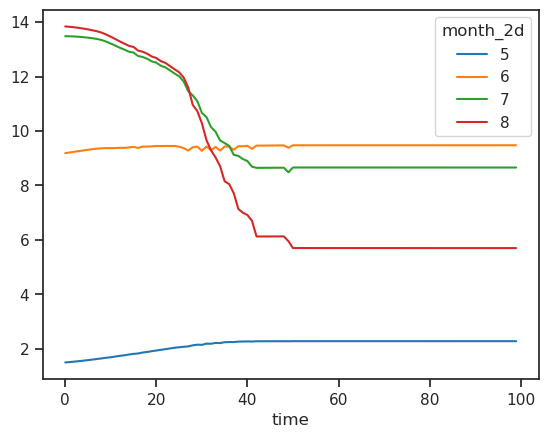
The runoff is approx. zero in the winter months, and is high in summer. The annual cycle changes as the glacier retreats:
monthly_runoff.sel(time=[0, 30, 99]).plot(hue='time'); plt.title('Annual cycle'); plt.xlabel('Month'); plt.ylabel('Runoff (Mt)');
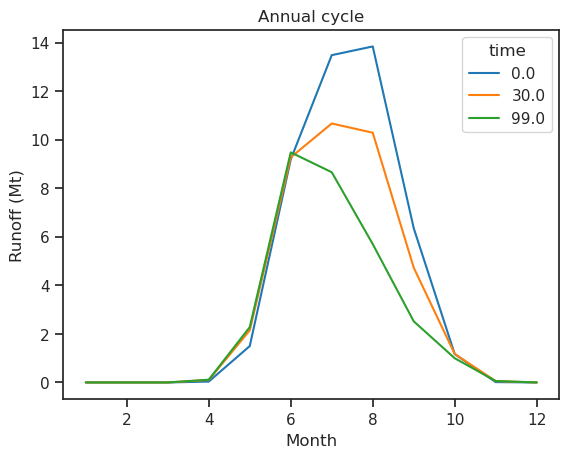
Let’s distinguish between the various components of the monthly runnoff for two 10 years periods (begining and end of the 100 year simulation):
# Pick the variables we need (the 2d ones)
sel_vars = [v for v in ds_roll.variables if 'month_2d' in ds_roll[v].dims]
# Pick the first decade and average it
df_m_s = ds_roll[sel_vars].isel(time=slice(0, 10)).mean(dim='time').to_dataframe() * 1e-9
# Rename the columns for readability
df_m_s.columns = [c.replace('_monthly', '') for c in df_m_s.columns]
# Because of floating point precision sometimes runoff can be slightly below zero, clip
df_m_s = df_m_s.clip(0)
# Same for end
df_m_e = ds_roll[sel_vars].isel(time=slice(-11, -1)).mean(dim='time').to_dataframe() * 1e-9
df_m_e.columns = [c.replace('_monthly', '') for c in df_m_s.columns]
df_m_e = df_m_e.clip(0)
f, (ax1, ax2) = plt.subplots(1, 2, figsize=(18, 7), sharey=True);
df_m_s[runoff_vars].plot.area(ax=ax1, legend=False, title='Year 0-10', color=sns.color_palette("rocket"));
df_m_e[runoff_vars].plot.area(ax=ax2, title='Year 90-100', color=sns.color_palette("rocket"));
ax1.set_ylabel('Monthly runoff (Mt)'); ax1.set_xlabel('Month'); ax2.set_xlabel('Month');
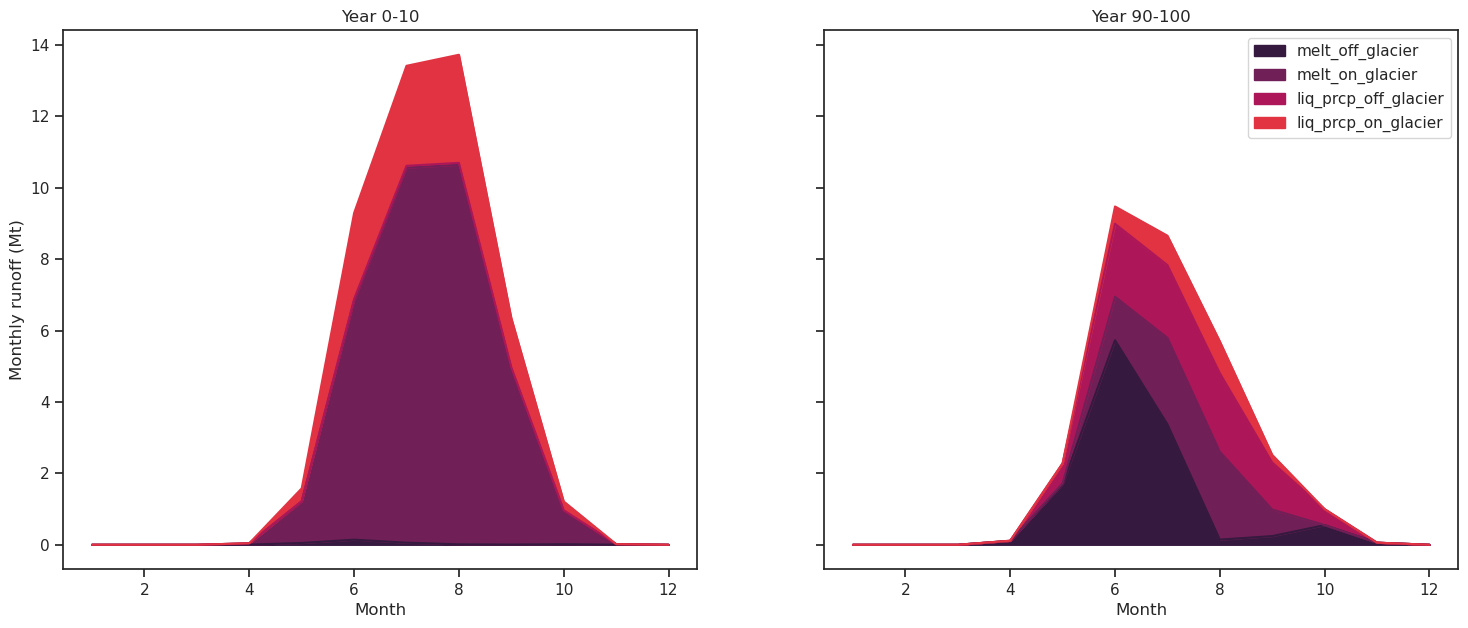
Random climate commitment run#
Same as before, but this time randomly shuffling each year of the last 11 years:
# file identifier where the model output is saved
file_id = '_rd'
tasks.run_with_hydro(gdir, run_task=tasks.run_random_climate, nyears=100, y0=2014, halfsize=5, store_monthly_hydro=True,
seed=0, unique_samples=True,
output_filesuffix=file_id);
/usr/local/pyenv/versions/3.10.10/lib/python3.10/site-packages/oggm/utils/_workflow.py:2939: UserWarning: Unpickling a shapely <2.0 geometry object. Please save the pickle again; shapely 2.1 will not have this compatibility.
out = pickle.load(f)
with xr.open_dataset(gdir.get_filepath('model_diagnostics', filesuffix=file_id)) as ds:
# The last step of hydrological output is NaN (we can't compute it for this year)
ds = ds.isel(time=slice(0, -1)).load()
Annual runoff#
sel_vars = [v for v in ds.variables if 'month_2d' not in ds[v].dims]
df_annual = ds[sel_vars].to_dataframe()
# Select only the runoff variables and convert them to megatonnes (instead of kg)
runoff_vars = ['melt_off_glacier', 'melt_on_glacier', 'liq_prcp_off_glacier', 'liq_prcp_on_glacier']
df_runoff = df_annual[runoff_vars] * 1e-9
f, ax = plt.subplots(figsize=(10, 6));
df_runoff.plot.area(ax=ax, color=sns.color_palette("rocket")); plt.xlabel('Years'); plt.ylabel('Runoff (Mt)'); plt.title(rgi_id);
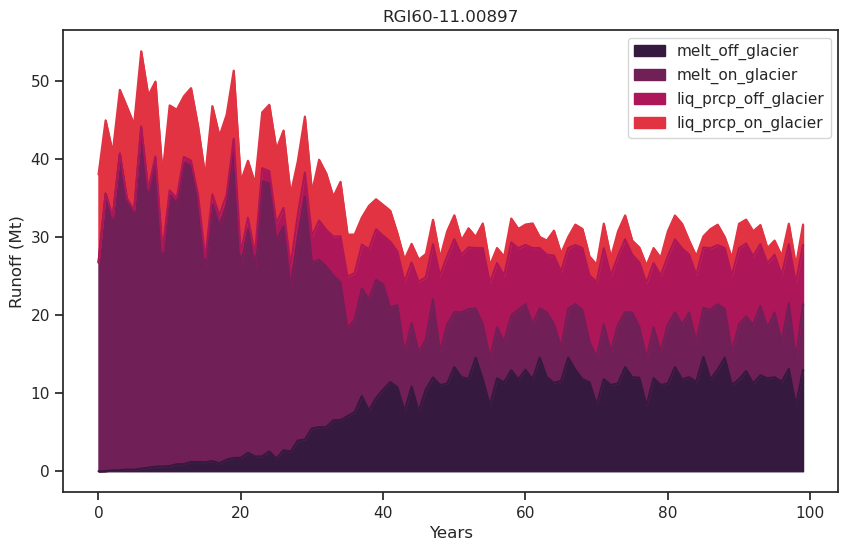
Monthly runoff#
ds_roll = ds.roll(month_2d=ds['calendar_month_2d'].data[0]-1, roll_coords=True)
ds_roll['month_2d'] = ds_roll['calendar_month_2d']
# Select only the runoff variables and convert them to megatonnes (instead of kg)
monthly_runoff = ds_roll['melt_off_glacier_monthly'] + ds_roll['melt_on_glacier_monthly'] + ds_roll['liq_prcp_off_glacier_monthly'] + ds_roll['liq_prcp_on_glacier_monthly']
monthly_runoff *= 1e-9
monthly_runoff.clip(0).plot(cmap='Blues', cbar_kwargs={'label':'Mt'}); plt.xlabel('Months'); plt.ylabel('Years');
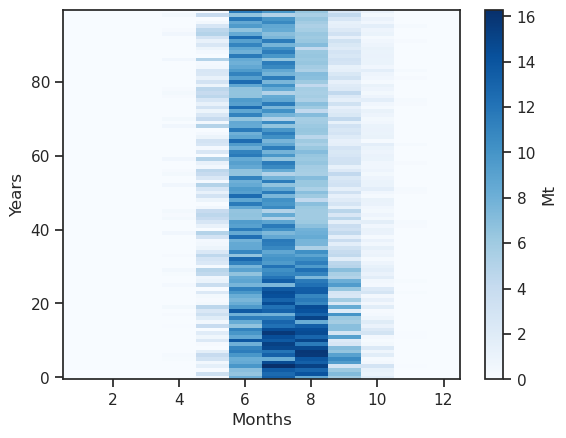
# Pick the variables we need (the 2d ones)
sel_vars = [v for v in ds_roll.variables if 'month_2d' in ds_roll[v].dims]
# Pick the first decade and average it
df_m_s = ds_roll[sel_vars].isel(time=slice(0, 10)).mean(dim='time').to_dataframe() * 1e-9
# Rename the columns for readability
df_m_s.columns = [c.replace('_monthly', '') for c in df_m_s.columns]
# Because of floating point precision sometimes runoff can be slightly below zero, clip
df_m_s = df_m_s.clip(0)
# Same for end
df_m_e = ds_roll[sel_vars].isel(time=slice(-11, -1)).mean(dim='time').to_dataframe() * 1e-9
df_m_e.columns = [c.replace('_monthly', '') for c in df_m_s.columns]
df_m_e = df_m_e.clip(0)
f, (ax1, ax2) = plt.subplots(1, 2, figsize=(18, 7), sharey=True);
df_m_s[runoff_vars].plot.area(ax=ax1, legend=False, title='Year 0-10', color=sns.color_palette("rocket"));
df_m_e[runoff_vars].plot.area(ax=ax2, title='Year 90-100', color=sns.color_palette("rocket"));
ax1.set_ylabel('Monthly runoff (Mt)'); ax1.set_xlabel('Month'); ax2.set_xlabel('Month');
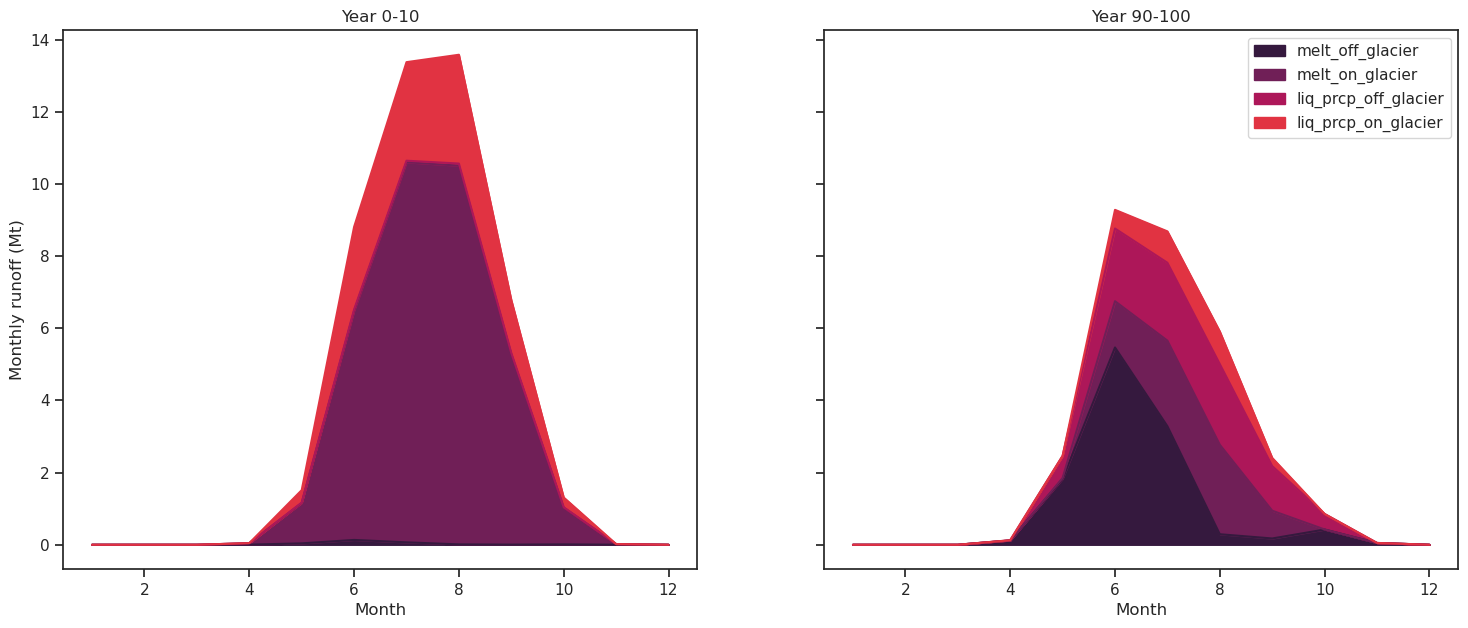
CMIP5 projection run#
This time, let’s start from the estimated glacier state in 2020 and run a projection from there. See the run_with_gcm tutorial for more info.
For illustrative purposes, we also show how you can use two new keywords added in OGGM v1.5.3 to:
compute hydrological outputs with a fixed geometry prior to the RGI date
compute the hydrological outputs with the same reference glacier area in the projections and the past simulation
For an (experimental) use of a dynamic spinup instead of this fixed geometry spinup, visit dynamical_spinup.ipynb.
“Historical” run for the reference climate period#
# Run the historical period with a fixed geometry spinup
file_id = '_hist_hydro'
tasks.run_with_hydro(gdir, run_task=tasks.run_from_climate_data,
fixed_geometry_spinup_yr=1990, # this tells to do spinup
ref_area_from_y0=True, #
store_monthly_hydro=True,
output_filesuffix=file_id);
/usr/local/pyenv/versions/3.10.10/lib/python3.10/site-packages/oggm/utils/_workflow.py:2939: UserWarning: Unpickling a shapely <2.0 geometry object. Please save the pickle again; shapely 2.1 will not have this compatibility.
out = pickle.load(f)
# Read the data
with xr.open_dataset(gdir.get_filepath('model_diagnostics', filesuffix=file_id)) as ds:
ds = ds.isel(time=slice(0, -1)).load()
sel_vars = [v for v in ds.variables if 'month_2d' not in ds[v].dims]
df_annual = ds[sel_vars].to_dataframe()
f, ax = plt.subplots(figsize=(9, 6))
df_annual[['volume_m3', 'area_m2']].plot(ax=ax, secondary_y='area_m2');
plt.suptitle(f'Glacier volume and area with fixed geometry spinup (RGI date: {gdir.rgi_date})');
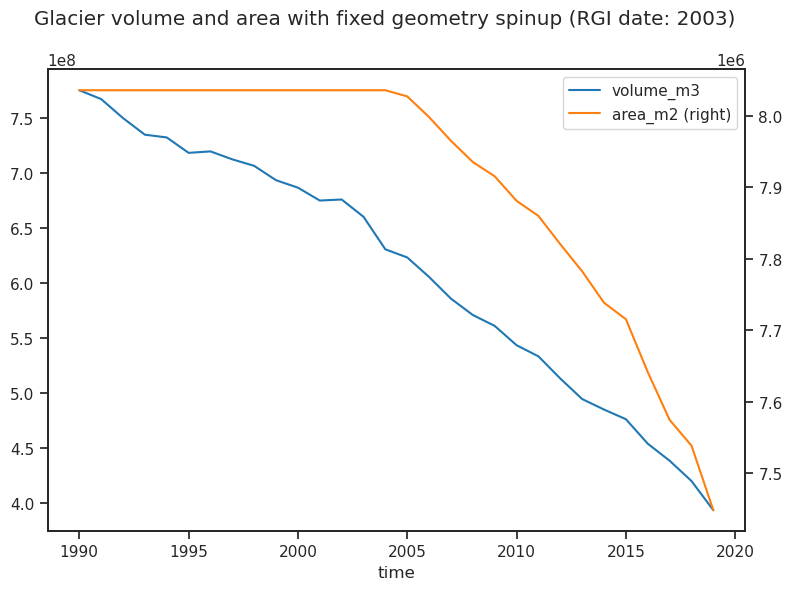
The plot shows what OGGM has done: glacier area is left constant until the RGI date, after which the dynamical model is used. Glacier volume however does vary, and is consistent with the glacier surface mass-balance (albeit without geometry feedbacks). The hydrological output is also consistent with climate and a fixed glacier geometry:
# Select only the runoff variables and convert them to megatonnes (instead of kg)
f, ax = plt.subplots(figsize=(10, 6));
(df_annual[runoff_vars] * 1e-9).plot.area(ax=ax, color=sns.color_palette("rocket"));
plt.xlabel('Years'); plt.ylabel('Runoff (Mt)'); plt.title(rgi_id);
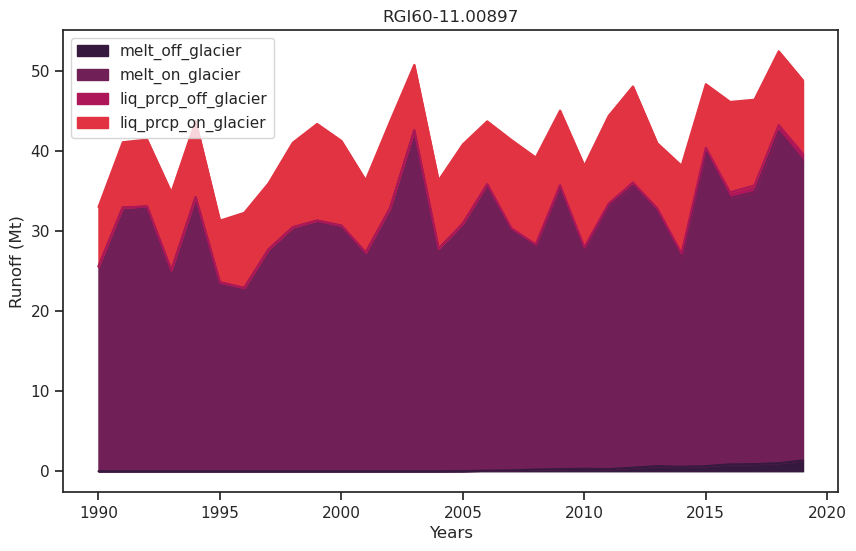
Projection run#
# "Downscale" the climate data
from oggm.shop import gcm_climate
bp = 'https://cluster.klima.uni-bremen.de/~oggm/cmip5-ng/pr/pr_mon_CCSM4_{}_r1i1p1_g025.nc'
bt = 'https://cluster.klima.uni-bremen.de/~oggm/cmip5-ng/tas/tas_mon_CCSM4_{}_r1i1p1_g025.nc'
for rcp in ['rcp26', 'rcp45', 'rcp60', 'rcp85']:
# Download the files
ft = utils.file_downloader(bt.format(rcp))
fp = utils.file_downloader(bp.format(rcp))
# bias correct them
workflow.execute_entity_task(gcm_climate.process_cmip_data, [gdir],
filesuffix='_CCSM4_{}'.format(rcp), # recognize the climate file for later
fpath_temp=ft, # temperature projections
fpath_precip=fp, # precip projections
);
2023-03-07 12:27:48: oggm.workflow: Execute entity tasks [process_cmip_data] on 1 glaciers
2023-03-07 12:28:02: oggm.workflow: Execute entity tasks [process_cmip_data] on 1 glaciers
2023-03-07 12:28:16: oggm.workflow: Execute entity tasks [process_cmip_data] on 1 glaciers
2023-03-07 12:28:30: oggm.workflow: Execute entity tasks [process_cmip_data] on 1 glaciers
for rcp in ['rcp26', 'rcp45', 'rcp60', 'rcp85']:
rid = '_CCSM4_{}'.format(rcp)
tasks.run_with_hydro(gdir, run_task=tasks.run_from_climate_data,
climate_filename='gcm_data', # use gcm_data, not climate_historical
climate_input_filesuffix=rid, # use the chosen scenario
init_model_filesuffix='_hist_hydro', # this is important! Start from 2020 glacier
ref_geometry_filesuffix='_hist_hydro', # also use this as area reference
ref_area_from_y0=True, # and keep the same reference area as for the historical simulations
output_filesuffix=rid, # recognize the run for later
store_monthly_hydro=True, # add monthly diagnostics
);
/usr/local/pyenv/versions/3.10.10/lib/python3.10/site-packages/oggm/utils/_workflow.py:2939: UserWarning: Unpickling a shapely <2.0 geometry object. Please save the pickle again; shapely 2.1 will not have this compatibility.
out = pickle.load(f)
/usr/local/pyenv/versions/3.10.10/lib/python3.10/site-packages/oggm/utils/_workflow.py:2939: UserWarning: Unpickling a shapely <2.0 geometry object. Please save the pickle again; shapely 2.1 will not have this compatibility.
out = pickle.load(f)
/usr/local/pyenv/versions/3.10.10/lib/python3.10/site-packages/oggm/utils/_workflow.py:2939: UserWarning: Unpickling a shapely <2.0 geometry object. Please save the pickle again; shapely 2.1 will not have this compatibility.
out = pickle.load(f)
/usr/local/pyenv/versions/3.10.10/lib/python3.10/site-packages/oggm/utils/_workflow.py:2939: UserWarning: Unpickling a shapely <2.0 geometry object. Please save the pickle again; shapely 2.1 will not have this compatibility.
out = pickle.load(f)
RCP2.6#
file_id = '_CCSM4_rcp26'
with xr.open_dataset(gdir.get_filepath('model_diagnostics', filesuffix=file_id)) as ds:
# The last step of hydrological output is NaN (we can't compute it for this year)
ds = ds.isel(time=slice(0, -1)).load()
ds.volume_m3.plot();
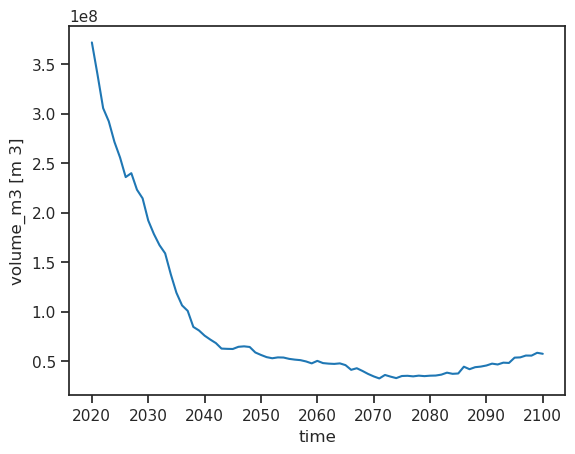
Annual runoff#
sel_vars = [v for v in ds.variables if 'month_2d' not in ds[v].dims]
df_annual = ds[sel_vars].to_dataframe()
# Select only the runoff variables and convert them to megatonnes (instead of kg)
runoff_vars = ['melt_off_glacier', 'melt_on_glacier', 'liq_prcp_off_glacier', 'liq_prcp_on_glacier']
df_runoff = df_annual[runoff_vars].clip(0) * 1e-9
f, ax = plt.subplots(figsize=(10, 6));
df_runoff.plot.area(ax=ax, color=sns.color_palette("rocket")); plt.xlabel('Years'); plt.ylabel('Runoff (Mt)'); plt.title(rgi_id);
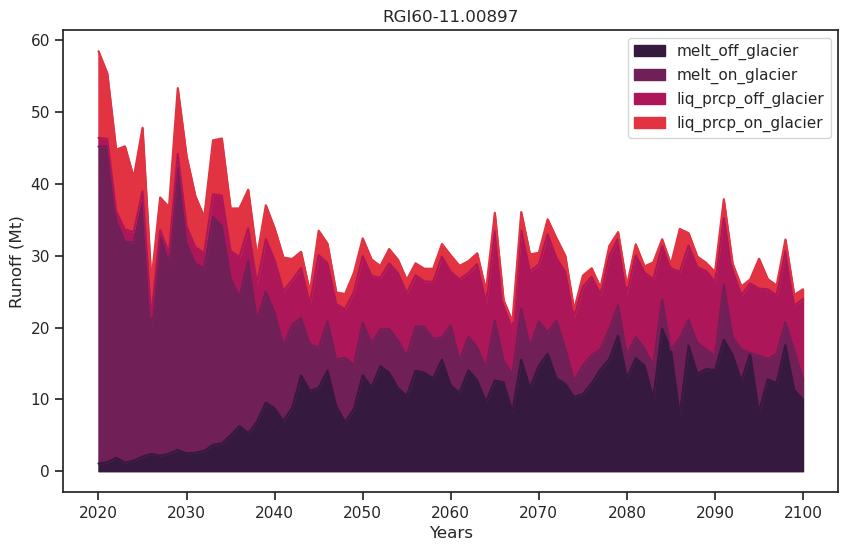
Note that “melt_off_glacier” is not zero at the beginning of the simulation - indeed the reference area is that of the 2003 glacier.
Monthly runoff#
ds_roll = ds.roll(month_2d=ds['calendar_month_2d'].data[0]-1, roll_coords=True)
ds_roll['month_2d'] = ds_roll['calendar_month_2d']
# Pick the variables we need (the 2d ones)
sel_vars = [v for v in ds_roll.variables if 'month_2d' in ds_roll[v].dims]
# Pick the first decade and average it
df_m_s = ds_roll[sel_vars].isel(time=slice(0, 10)).mean(dim='time').to_dataframe() * 1e-9
# Rename the columns for readability
df_m_s.columns = [c.replace('_monthly', '') for c in df_m_s.columns]
# Because of floating point precision sometimes runoff can be slightly below zero, clip
df_m_s = df_m_s.clip(0)
# Same for end
df_m_e = ds_roll[sel_vars].isel(time=slice(-11, -1)).mean(dim='time').to_dataframe() * 1e-9
df_m_e.columns = [c.replace('_monthly', '') for c in df_m_s.columns]
df_m_e = df_m_e.clip(0)
f, (ax1, ax2) = plt.subplots(1, 2, figsize=(18, 7), sharey=True);
df_m_s[runoff_vars].plot.area(ax=ax1, legend=False, title='Year 0-10', color=sns.color_palette("rocket"));
df_m_e[runoff_vars].plot.area(ax=ax2, title='Year 90-100', color=sns.color_palette("rocket"));
ax1.set_ylabel('Monthly runoff (Mt)'); ax1.set_xlabel('Month'); ax2.set_xlabel('Month');
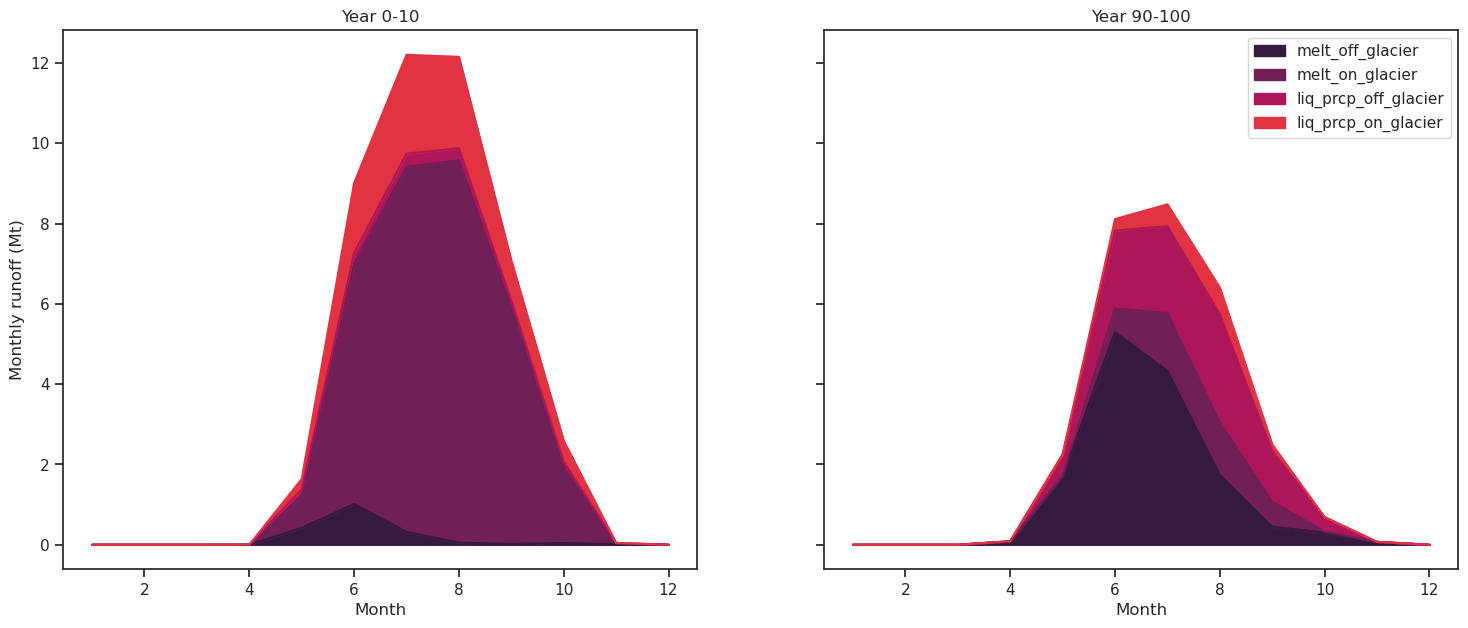
RCP8.5#
file_id = '_CCSM4_rcp85'
with xr.open_dataset(gdir.get_filepath('model_diagnostics', filesuffix=file_id)) as ds:
# The last step of hydrological output is NaN (we can't compute it for this year)
ds = ds.isel(time=slice(0, -1)).load()
ds.volume_m3.plot();
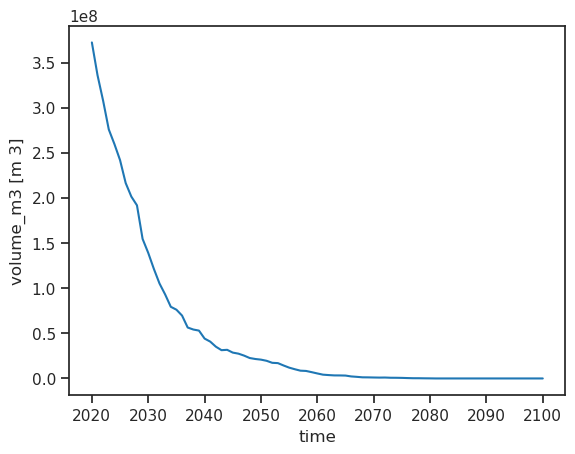
Annual runoff#
sel_vars = [v for v in ds.variables if 'month_2d' not in ds[v].dims]
df_annual = ds[sel_vars].to_dataframe()
# Select only the runoff variables and convert them to megatonnes (instead of kg)
runoff_vars = ['melt_off_glacier', 'melt_on_glacier', 'liq_prcp_off_glacier', 'liq_prcp_on_glacier']
df_runoff = df_annual[runoff_vars] * 1e-9
f, ax = plt.subplots(figsize=(10, 6));
df_runoff.plot.area(ax=ax, color=sns.color_palette("rocket")); plt.xlabel('Years'); plt.ylabel('Runoff (Mt)'); plt.title(rgi_id);
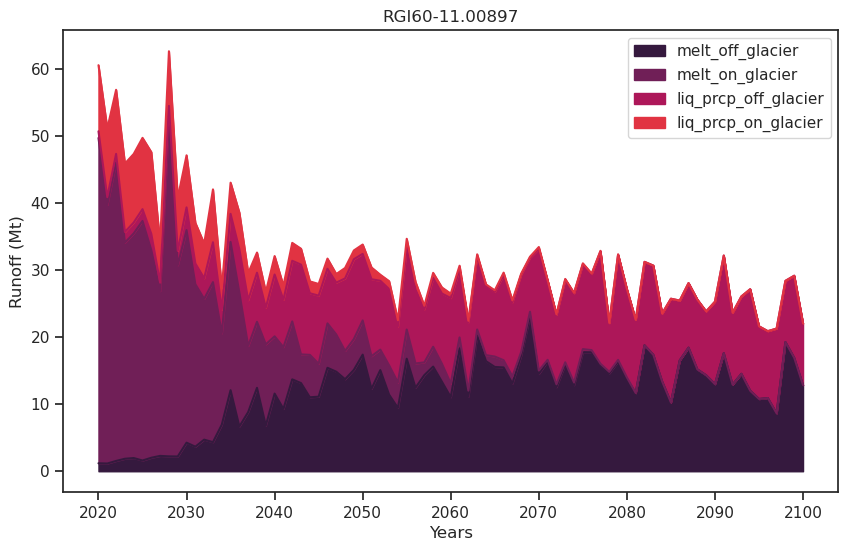
Monthly runoff#
ds_roll = ds.roll(month_2d=ds['calendar_month_2d'].data[0]-1, roll_coords=True)
ds_roll['month_2d'] = ds_roll['calendar_month_2d']
# Pick the variables we need (the 2d ones)
sel_vars = [v for v in ds_roll.variables if 'month_2d' in ds_roll[v].dims]
# Pick the first decade and average it
df_m_s = ds_roll[sel_vars].isel(time=slice(0, 10)).mean(dim='time').to_dataframe() * 1e-9
# Rename the columns for readability
df_m_s.columns = [c.replace('_monthly', '') for c in df_m_s.columns]
# Because of floating point precision sometimes runoff can be slightly below zero, clip
df_m_s = df_m_s.clip(0)
# Same for end
df_m_e = ds_roll[sel_vars].isel(time=slice(-11, -1)).mean(dim='time').to_dataframe() * 1e-9
df_m_e.columns = [c.replace('_monthly', '') for c in df_m_s.columns]
df_m_e = df_m_e.clip(0)
f, (ax1, ax2) = plt.subplots(1, 2, figsize=(18, 7), sharey=True);
df_m_s[runoff_vars].plot.area(ax=ax1, legend=False, title='Year 0-10', color=sns.color_palette("rocket"));
df_m_e[runoff_vars].plot.area(ax=ax2, title='Year 90-100', color=sns.color_palette("rocket"));
ax1.set_ylabel('Monthly runoff (Mt)'); ax1.set_xlabel('Month'); ax2.set_xlabel('Month');
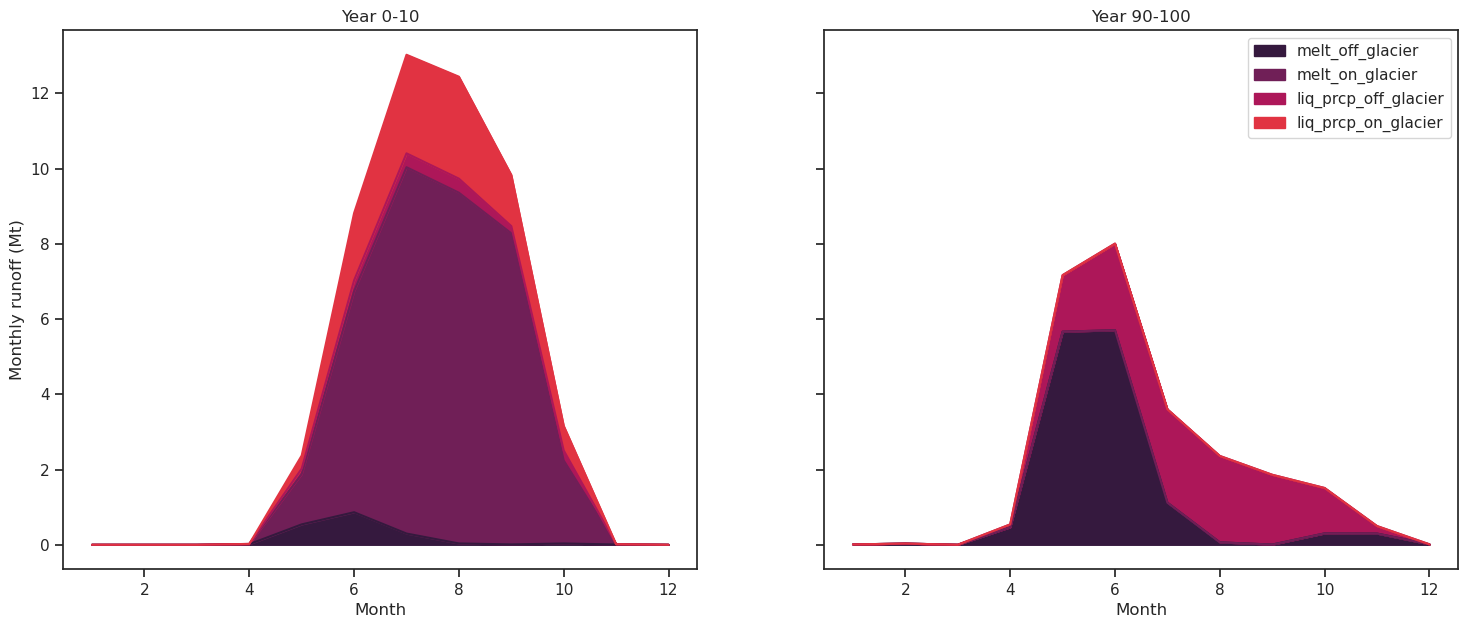
Calculating peak water under different climate scenarios#
A typical usecase for simulating and analysing the hydrological ouptuts of glaciers are for peak water estimations. For instance, we might want to know the point in time when the annual total runoff from a glacier reaches its maximum under a certain climate scenario.
The total runoff is a sum of the melt and liquid precipitation, from both on and off the glacier. Peak water can be calculated from the 11-year moving average of the total runoff (Huss and Hock, 2018).
For Hintereisferner we have alredy run the simulations for the different climate scenarios, so we can sum up the runoff variables and plot the output.
# Create the figure
f, ax = plt.subplots(figsize=(18, 7), sharex=True)
# Loop all scenarios
for i, rcp in enumerate(['rcp26', 'rcp45', 'rcp60', 'rcp85']):
file_id = f'_CCSM4_{rcp}'
# Open the corresponding data.
with xr.open_dataset(gdir.get_filepath('model_diagnostics',
filesuffix=file_id)) as ds:
# Load the data into a dataframe
ds = ds.isel(time=slice(0, -1)).load()
# Select annual variables
sel_vars = [v for v in ds.variables if 'month_2d' not in ds[v].dims]
# And create a dataframe
df_annual = ds[sel_vars].to_dataframe()
# Select the variables relevant for runoff.
runoff_vars = ['melt_off_glacier', 'melt_on_glacier',
'liq_prcp_off_glacier', 'liq_prcp_on_glacier']
# Convert to mega tonnes instead of kg.
df_runoff = df_annual[runoff_vars].clip(0) * 1e-9
# Sum the variables each year "axis=1", take the 11 year rolling mean
# and plot it.
running = df_runoff.sum(axis=1).rolling(window=11).mean()
running.plot(ax=ax, label=rcp, color=sns.color_palette("rocket")[i])
ax.set_ylabel('Annual runoff (Mt)')
ax.set_xlabel('Year')
plt.title(rgi_id)
plt.legend();
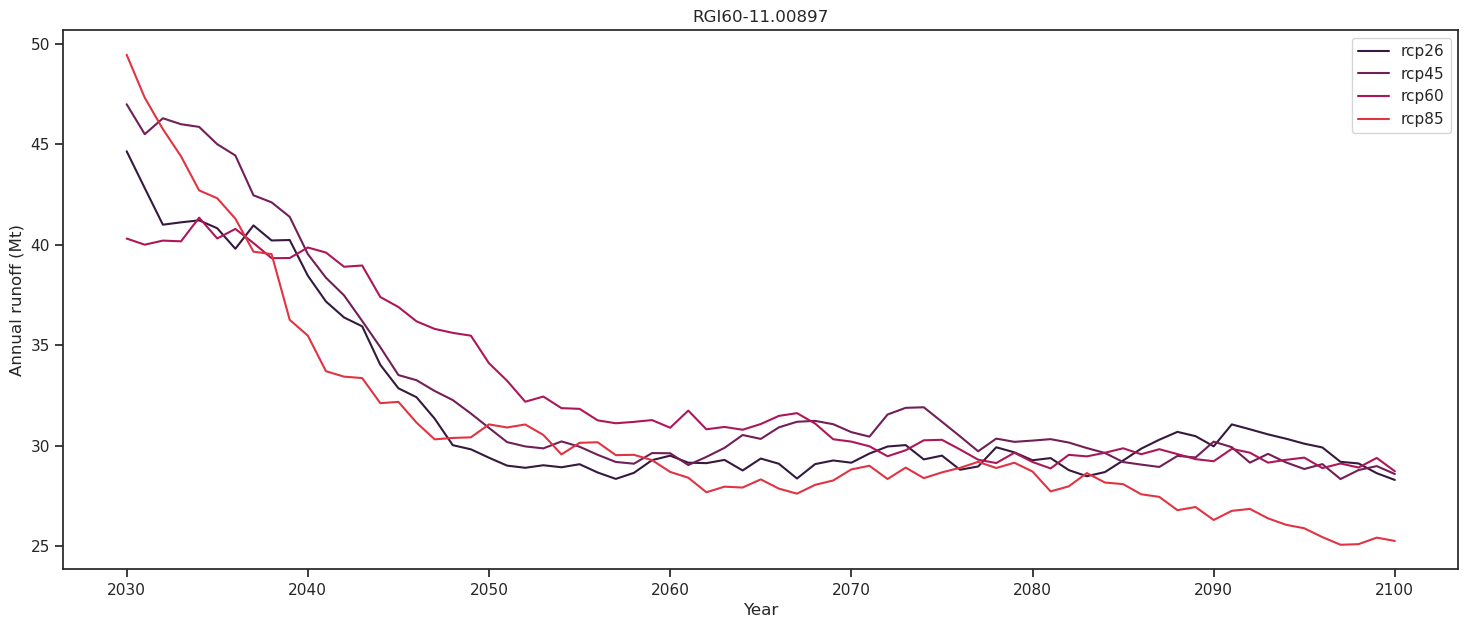
For Hintereisferner, runoff continues to decrease throughout the 21st-century for all scenarios, indicating that peak water has already been reached sometime in the past. This is the case for many European glaciers. Let us take a look at another glacier, in a different climatical setting where a different hydrological projection can be expected.
We pick a glacier (RGI60-15.02420, unnamed) in the Eastern Himalayas. First we need to initialize its glacier directory.
# Unnamed glacier
rgi_id = 'RGI60-15.02420'
gdir = workflow.init_glacier_directories([rgi_id], from_prepro_level=5, prepro_border=80, prepro_base_url=base_url)[0]
2023-03-07 12:28:37: oggm.workflow: init_glacier_directories from prepro level 5 on 1 glaciers.
2023-03-07 12:28:37: oggm.workflow: Execute entity tasks [gdir_from_prepro] on 1 glaciers
---------------------------------------------------------------------------
TypeError Traceback (most recent call last)
Cell In[51], line 1
----> 1 gdir = workflow.init_glacier_directories([rgi_id], from_prepro_level=5, prepro_border=80, prepro_base_url=base_url)[0]
File /usr/local/pyenv/versions/3.10.10/lib/python3.10/site-packages/oggm/workflow.py:533, in init_glacier_directories(rgidf, reset, force, from_prepro_level, prepro_border, prepro_rgi_version, prepro_base_url, from_tar, delete_tar)
531 if cfg.PARAMS['dl_verify']:
532 utils.get_dl_verify_data('cluster.klima.uni-bremen.de')
--> 533 gdirs = execute_entity_task(gdir_from_prepro, entities,
534 from_prepro_level=from_prepro_level,
535 prepro_border=prepro_border,
536 prepro_rgi_version=prepro_rgi_version,
537 base_url=prepro_base_url)
538 else:
539 # We can set the intersects file automatically here
540 if (cfg.PARAMS['use_intersects'] and
541 len(cfg.PARAMS['intersects_gdf']) == 0 and
542 not from_tar):
File /usr/local/pyenv/versions/3.10.10/lib/python3.10/site-packages/oggm/workflow.py:191, in execute_entity_task(task, gdirs, **kwargs)
187 if ng > 3:
188 log.workflow('WARNING: you are trying to run an entity task on '
189 '%d glaciers with multiprocessing turned off. OGGM '
190 'will run faster with multiprocessing turned on.', ng)
--> 191 out = [pc(gdir) for gdir in gdirs]
193 return out
File /usr/local/pyenv/versions/3.10.10/lib/python3.10/site-packages/oggm/workflow.py:191, in <listcomp>(.0)
187 if ng > 3:
188 log.workflow('WARNING: you are trying to run an entity task on '
189 '%d glaciers with multiprocessing turned off. OGGM '
190 'will run faster with multiprocessing turned on.', ng)
--> 191 out = [pc(gdir) for gdir in gdirs]
193 return out
File /usr/local/pyenv/versions/3.10.10/lib/python3.10/site-packages/oggm/workflow.py:108, in _pickle_copier.__call__(self, arg)
106 for func in self.call_func:
107 func, kwargs = func
--> 108 res = self._call_internal(func, arg, kwargs)
109 return res
File /usr/local/pyenv/versions/3.10.10/lib/python3.10/site-packages/oggm/workflow.py:102, in _pickle_copier._call_internal(self, call_func, gdir, kwargs)
99 gdir, gdir_kwargs = gdir
100 kwargs.update(gdir_kwargs)
--> 102 return call_func(gdir, **kwargs)
File /usr/local/pyenv/versions/3.10.10/lib/python3.10/site-packages/oggm/workflow.py:251, in gdir_from_prepro(entity, from_prepro_level, prepro_border, prepro_rgi_version, base_url)
248 tar_base = utils.get_prepro_gdir(prepro_rgi_version, rid, prepro_border,
249 from_prepro_level, base_url=base_url)
250 from_tar = os.path.join(tar_base.replace('.tar', ''), rid + '.tar.gz')
--> 251 return oggm.GlacierDirectory(entity, from_tar=from_tar)
File /usr/local/pyenv/versions/3.10.10/lib/python3.10/site-packages/oggm/utils/_workflow.py:2529, in GlacierDirectory.__init__(self, rgi_entity, base_dir, reset, from_tar, delete_tar)
2525 raise RuntimeError('RGI Version not supported: '
2526 '{}'.format(self.rgi_version))
2528 # remove spurious characters and trailing blanks
-> 2529 self.name = filter_rgi_name(name)
2531 # region
2532 reg_names, subreg_names = parse_rgi_meta(version=self.rgi_version[0])
File /usr/local/pyenv/versions/3.10.10/lib/python3.10/site-packages/oggm/utils/_funcs.py:734, in filter_rgi_name(name)
728 def filter_rgi_name(name):
729 """Remove spurious characters and trailing blanks from RGI glacier name.
730
731 This seems to be unnecessary with RGI V6
732 """
--> 734 if name is None or len(name) == 0:
735 return ''
737 if name[-1] in ['À', 'È', 'è', '\x9c', '3', 'Ð', '°', '¾',
738 '\r', '\x93', '¤', '0', '`', '/', 'C', '@',
739 'Å', '\x06', '\x10', '^', 'å', ';']:
TypeError: object of type 'numpy.float64' has no len()
Then, we have to process the climate data for the new glacier.
# Do we need to download data again? I guess it is stored somewhere,
# but this is an easy way to loop over it for bias correction.
bp = 'https://cluster.klima.uni-bremen.de/~oggm/cmip5-ng/pr/pr_mon_CCSM4_{}_r1i1p1_g025.nc'
bt = 'https://cluster.klima.uni-bremen.de/~oggm/cmip5-ng/tas/tas_mon_CCSM4_{}_r1i1p1_g025.nc'
for rcp in ['rcp26', 'rcp45', 'rcp60', 'rcp85']:
# Download the files
ft = utils.file_downloader(bt.format(rcp))
fp = utils.file_downloader(bp.format(rcp))
workflow.execute_entity_task(gcm_climate.process_cmip_data, [gdir],
# Name file to recognize it later
filesuffix='_CCSM4_{}'.format(rcp),
# temperature projections
fpath_temp=ft,
# precip projections
fpath_precip=fp,
);
With this done, we can run the simulations for the different climate scenarios (for simplicity here, we don’t care about historical simulations).
for rcp in ['rcp26', 'rcp45', 'rcp60', 'rcp85']:
rid = '_CCSM4_{}'.format(rcp)
tasks.run_with_hydro(gdir, run_task=tasks.run_from_climate_data, ys=2020,
# use gcm_data, not climate_historical
climate_filename='gcm_data',
# use the chosen scenario
climate_input_filesuffix=rid,
# this is important! Start from 2020 glacier
init_model_filesuffix='_historical',
# recognize the run for later
output_filesuffix=rid,
# add monthly diagnostics
store_monthly_hydro=True,
);
Now we can create the same plot as before in order to visualize peak water
# Create the figure
f, ax = plt.subplots(figsize=(18, 7))
# Loop all scenarios
for i, rcp in enumerate(['rcp26', 'rcp45', 'rcp60', 'rcp85']):
file_id = f'_CCSM4_{rcp}'
# Open the corresponding data in a context manager.
with xr.open_dataset(gdir.get_filepath('model_diagnostics',
filesuffix=file_id)) as ds:
# Load the data into a dataframe
ds = ds.isel(time=slice(0, -1)).load()
# Select annual variables
sel_vars = [v for v in ds.variables if 'month_2d' not in ds[v].dims]
# And create a dataframe
df_annual = ds[sel_vars].to_dataframe()
# Select the variables relevant for runoff.
runoff_vars = ['melt_off_glacier', 'melt_on_glacier',
'liq_prcp_off_glacier', 'liq_prcp_on_glacier']
# Convert to mega tonnes instead of kg.
df_runoff = df_annual[runoff_vars].clip(0) * 1e-9
# Sum the variables each year "axis=1", take the 11 year rolling mean
# and plot it.
df_runoff.sum(axis=1).rolling(window=11).mean().plot(ax=ax, label=rcp,
color=sns.color_palette("rocket")[i]
)
ax.set_ylabel('Annual runoff (Mt)')
ax.set_xlabel('Year')
plt.title(rgi_id)
plt.legend();
Unlike for Hintereisferner, these projections indicate that the annual runoff will increase in all the scenarios for the first half of the century. The higher RCP scenarios can reach peak water later in the century, since the excess melt can continue to increase. For the lower RCP scenarios on the other hand, the glacier might be approaching a new equilibirum, which reduces the runoff earlier in the century (Rounce et. al., 2020). After peak water is reached (RCP2.6: ~2055, RCP8.5: ~2070 in these projections), the annual runoff begin to decrease. This decrease occurs because the shrinking glacier is no longer able to support the high levels of melt.
What’s next?#
return to the OGGM documentation
back to the table of contents


